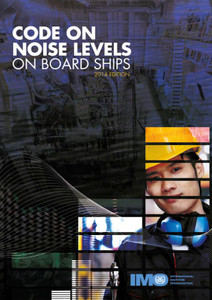
This IMO publication contains the Code on Noise Levels on Board Ships (resolution A.468(XII)) and the Recommendation on methods of measuring noise levels at listening posts (resolution A.343(IX)) (K814E).
Continuous noise on board ships can have an adverse impact on human health. In addition, underwater-radiated noise from ships may have both short and long-term negative consequences on marine life, especially marine mammals.
The Code on Noise Levels on Board Ship was developed to provide guidance to Administrations on principles of noise control on board ships and to stimulate and promote noise control at a national level within the framework of internationally agreed guidelines. The Code sets out mandatory maximum noise level limits for machinery spaces, control rooms, workshops, accommodation and other spaces on board ships.
I – CODE ON NOISE LEVELS ON BOARD SHIPS
Preamble
1 The Code on Noise Levels on Board Ship (hereinafter referred to as the Code) has been developed to provide guidance to Administrations on principles of noise control on board ships in general. Its purpose is to stimulate and promote noise control at a national level within the framework of internationally agreed guidelines.
2 Guidance to Administrations on maximum noise levels and noise exposure limits should be considered as the main objectives of the Code.
3 The recommendations on procedures and programmes should be regarded as an attempt to establish international uniformity rather than to set strict rules to be followed.
4 The Code has been developed having regard to conventional passenger and cargo ships. While certain types and sizes of ships have been excluded from application, it should be recognized that full application to ships which differ appreciably from the conventional types of ships regarding design or operations might need specific consideration.
5 The Code is not intended for direct incorporation by reference or reproduction in national legislation although it could provide a basis for such legislation.
6 The Organization adopted a recommendation on methods of measuring noise levels at listening posts with resolution A.343(IX). This recommendation related to interference by shipborne noise with the proper reception of external audible navigation signals and although the methods of measuring noise levels in accordance with resolution A.343(IX) and with the Code are different, these documents are considered compatible inasmuch as the Code is concerned primarily with the effect of noise on health and comfort.
I – CODE ON NOISE LEVELS ON BOARD SHIPS
Resolution A.468(XII)
Chapter 1 – General
1.1 Scope
1.2 Purpose
1.3 Application
1.4 Definitions
Chapter 2 – Measurement
2.1 General
2.2 Operating conditions at sea
2.3 Operating conditions in port
2.4 Environmental conditions
2.5 Safe measurement conditions
2.6 Measurement procedures
2.7 Calibration
2.8 Measurement positions
Chapter 3 – Measuring equipment
3.1 Equipment specifications
3.2 Use of equipment
Chapter 4 – Maximum acceptable sound pressure levels
4.1 General
4.2 Noise level limits
4.3 Survey report
Chapter 5 – Noise exposure limits
5.1 General
5.2 Hearing conservation and use of ear protectors
5.3 Limits of exposure of seafarers to high noise levels
5.4 24 hour equivalent continuous sound level limit
5.5 Hearing conservation programme
Chapter 6 – Acoustic insulation between accommodation spaces
6.1 General
6.2 Sound insulation index
6.3 Erection of materials
Chapter 7 – Ear protection and warning information
7.1 General
7.2 Recommendation for ear protectors
7.3 Selection and use of ear protectors
7.4 Warning notices
7.5 Miscellaneous equipment
Appendix 1 – Format for Noise Survey Report
Appendix 2 – Instructions to seafarers and responsibility
Appendix 3 – Suggested methods of controlling noise exposure
II – RECOMMENDATION ON METHODS OF MEASURING NOISE LEVELS AT LISTENING POSTS
Resolution A.343(IX)
Appendix – Provisional Guidelines on maximum acceptable noise levels at listening posts
A??s a specialized agency of the United Nations, IMO is the global standard-setting authority for the safety, security and environmental performance of international shipping. Its main role is to create a regulatory framework for the shipping industry that is fair and effective, universally adopted and universally implemented. ?
In other words, its role is to create a level playing-field so that ship operators cannot address their financial issues by simply cutting corners and compromising on safety, security and environmental performance. This approach also encourages innovation and efficiency.
Shipping is a truly international industry, and it can only operate effectively if the regulations and standards are themselves agreed, adopted and implemented on an international basis. And IMO is the forum at which this process takes place.
- Number of Pages:
- 44
- Published Date:
- April 2014
- Book Height:
- 250 mm
- Book Width:
- 10 mm
- Author:
International Maritime Organization
- ISBN:
- 9789280111347
- Preview:
- Yes






